I was first introduced to the term Flexible dieting or If It Fits Your Macros (IIFYM) by Layne Norton. Norton is a PhD in nutritional science, co-founder of  Avatar nutrition and USA Power lifting champion. His Twitter and Instagram feed is used as an outlet to dispel nutritional myths, disseminate scientifically reviewed information and provide entertaining rants that call out ‘Instagram trainers’ promoting pseudo training and nutrition tips.
Avatar nutrition and USA Power lifting champion. His Twitter and Instagram feed is used as an outlet to dispel nutritional myths, disseminate scientifically reviewed information and provide entertaining rants that call out ‘Instagram trainers’ promoting pseudo training and nutrition tips.
To understand what IIFYM is about you must have a basic understanding of what a macro, short for macronutrient, is. Macronutrients are the building blocks of energy we consume each day, you know them as protein, carbohydrates, fats and alcohol. The official site for IIFYM states, “For our purposes, fiber intake should be a major consideration when tracking macros; therefore we include it in with the other macros”[1].
How does it differ from other diets?
Flexible dieting takes in to account height, weight, gender, body fat percentage, activity level and a specific goal such as fat loss, muscle gain, maintenance. Once you have input your data it will calculate your daily caloric intake and macro requirements. There is no restriction on the type of food you eat, it holds you accountable and keeps you consistent to achieve results something Norton believes is the main point[2]. There is a myth that IIFYM/Flexible dieters are just eating “junk” which is not the case. A commonly used analogy to describe the eating habits of those who advocate for flexible dieting is that of a budget. For example: If you earn $50,000/year you can not afford to buy a $45,000 dollar sports car and expect to keep up with other bill payments. On the other hand, if you make $100,000/year you have the financial ability to spend more on luxuries. An individual with a faster metabolism, or a large budget, can afford to eat “junk” food by other dieting standards. Here is an example for an Active male:
Acceptable Macronutrient distribution ranges and calories/g
- CHO = 40 – 60% daily intake and = 4 kcal of energy
- Protein = 15 – 30% daily intake and = 4 kcal of energy
- Fats = 15 – 20% daily intake = 9 kcal of energy
This individual has a 2000-calorie “budget” and a goal to lower his body fat. It has been prescribed he allocate 50% of his caloric budget to CHO, 30% to protein and the last 20% allocated to fats. Based on his caloric budget, prescribed AMDR his daily macros would be 250/g of CHO, 150/g of protein and finally ~44/g fat per day. As his goals shift, so do his Macro and caloric intake for the day. If his budget is spent eating junk food he will use up his allotment of fat macros rather quickly making it tough to maintain his goals. Weighing and tracking the food you consume is the key to staying consistent with your goals. The more diligent you are with it the better you will become later on at estimating the macros in your meals. Sticking to a restrictive diet can be very tough; it requires a lot of will power to remove foods you once enjoyed. A flexible diet takes away any guilt you might have for enjoying a serving of ice cream or that burger and fries. If you stay accountable and if it fits your macros, you will still be on track of your goal with out the guilt. The cornerstone for any nutritional or fitness goal is consistency, if you stay on the course eventually you will get to where you want to be.
[1] https://www.iifym.com/what-is-iifym/
[2] https://www.bodybuilding.com/content/iifym-and-flexible-nutrition-interview-with-dr-layne-norton.html




